“Ethnobotanic: Only the blue or purple berries of elderberry are edible. Edible berries and flower are used for medicine, dyes for basketry, arrow shafts, flute, whistles, clapper sticks, and folk medicine. The active alkaloids in elderberry plants are hydrocyanic acid and sambucine. Both alkaloids will cause nausea so care should be observed with this plant. Elderberries are high in vitamin C. The red berries of other species are toxic and should not be gathered.
The wood is hard and has been used for combs, spindles, and pegs, and the hollow stems have been fashioned into flutes and blowguns.
Elderberries are quite edible. The blue or purple berries are gathered and made into elderberry wine, jam, syrup, and pies. The entire flower cluster can be dipped in batter and fried, while petals can be eaten raw or made into a fragrant and tasty tea. The flowers add an aromatic flavor and lightness to pancakes or fritters.
The elderberry is of well-known value to the Indians of North America and the many purposes it serves (Barrow 1967). Elderberry is highly prized by both Spaniards and Cahuillas. Throughout the months of July and August, the small clusters of berries are gathered in large quantities. These clusters are dried carefully on the drying floor and preserved in considerable amounts. When wanted, they are cooked into a rich sauce that needs no sweetening. A Cahuilla family, during this season of the year, will subsist largely on these messes of “sauco.” Frequently, the elderberry was so greatly enjoyed that families would live for weeks on little else. Many were dried for use in the winter, and were either re-cooked or eaten raw. Elderberries are still highly prized for food by modern Indian people.
Elderberry twigs and fruit are employed in creating dyes for basketry. These stems are dyed a very deep black by soaking them for a week or so in a wash made from the berry stems of the elderberry (Barrows 1967). The Cahuilla split basketry materials from the aromatic sumac (Rhus trilobata).
Elderberry branches were used to make the shaft of arrows. Flutes and whistles were constructed by boring holes into stems hollowed out with hot sticks. Clapper sticks were made by splitting the stem and clapping the two halves against each other. Clapper sticks were used ceremonially in the round-house to accompany singing and dancing. The pith of the stems was used as tinder, and the stem itself was employed as a twirling stick for starting the fire. Hollowed-out elderberry stems can be made into squirt guns.
In the middle ages, elderberry was considered a Holy Tree capable of restoring good health, keeping good health, and as an aid to longevity.
Fruits of blue elderberry are gathered from the wild for wine, jellies, candy, pies, and sauces. The plants are commercially cultivated for fruit production in Oregon. Sambucus canadensis and S. nigra have long been used in the same way, and cultivars of both have been developed. All parts of the elderberry plant are considered to be a valuable healing plant in many folk medicine traditions (Hutchens 1991, Walker et al. 1993; Barrett et al. 1933; Clarke 1977). Elderberry flowers contain flavenoids and rutin, which are known to improve immune function, particularly in combination with vitamin C. The flowers also contain tannins, which account for its traditional use to reduce bleeding, diarrhea, and congestion.
The flowers are the mildest part of the plant and when prepared as a tea, are used to break dry fevers and stimulate perspiration, aid headache, indigestion, twitching eyes, dropsy, rheumatism, appendix inflammation, bladder or kidney infections, colds, influenza, consumption (bleeding in lungs), and is helpful to newborn babies (Hutchens 1991). Used as a wash, the flowers or leaves are good for wounds, sprains, and bruises, as well as for sores on domestic animals. The leaves, which are stronger, have a slightly laxative property. Applied externally, leaves, flowers, bark and twigs are excellent as a poultice, mixed equally with chamomile, for soreness, inflammations, joint stiffness, and to reduce the swelling of bee stings. The flowers and berries, employed as a diuretic, can aid arthritis and rheumatism. Steeped in water, the flowers are used externally to aid in complexion beauty, tone and soften the skin, and lighten freckles or spots. The berry juice made into salve aids burns and scalds. The juice taken internally will act as a purgative.”
So, if you are looking for a wild edible plant that will boost your immune system through the winter months, and double as a tasty food, now is the time to go out and pick them! Even if you’re busy, just throw them in your freezer, and you’ll be well on your way to a well winter!
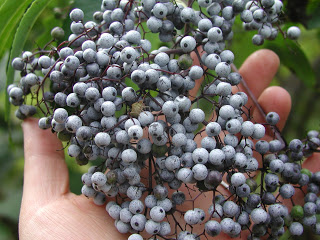
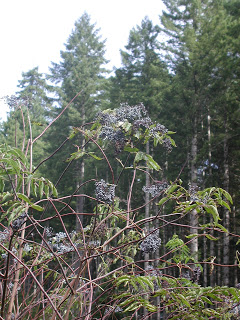
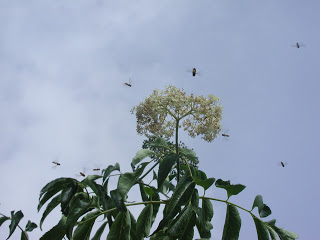
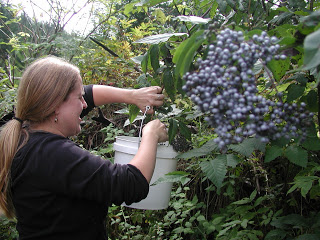
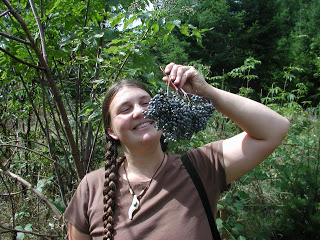
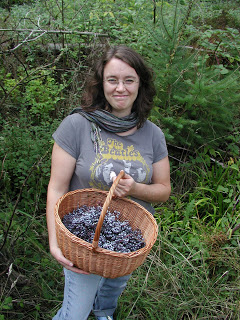
Can I ask how you add it to your kombutcha? do you steep it right into the tea? I would like to try adding it to my next batch. Thank you for a very informative post!
I brew my batch of Kombucha, and then I bottle it in individual bottles with about 2 tsp of sugar and a tablespoon of elderberries to ferment another 4 days in a dark cupboard. It comes out fizzy, fruity, and infused with the medicinal benefits of elderberries. I also add ginger, lavender, strawberries, blackberries, mint, or whatever is around and would make it tasty. My kids like it better with the added fruit. Enjoy!
Thank you so much. I can't wait to try this. I I have been wondering how people make to flavored Komutcha. So far all I have done is just regular batches. I am also glad to hear your kids drink it. Mine like drinking it and then on a website I found about Komutcha it said not to let kids drink it.I was so confused. Made me a little nervous b/c mine still want to drink it. Glad to know you give it to yours also.Thank you!